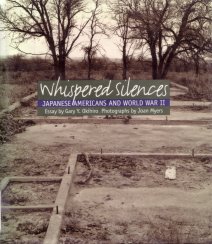
Whispered Silences: Japanese Americans and World War II

Gary Y. Okihiro, 1996.
The first section of the book consists of photographs of the various camps taken in the present day, showing bits and pieces of what is left as if being done in an archaeological study format. The pictures are black-and-white and quite interesting.
The next section of the book covers the history of Japanese immigration to the U.S. and Hawaii and is written with personal anecdotes along the way which makes it very interesting reading. It's also fascinating the way the author writes about how people's expectations of life in the U.S. didn't always match what actually happened (not counting the anti-Japanese prejudice.)
The next chapter has more information on how the Japanese gradually transferred from being Japanese to being Japanese-American, something which was obviously not easy. The chapter covers everything from changes in the foods used and how they were prepared on through the types of housing the people lived in. These two chapters deal with pre-WWII material.
The next chapter starts out with the attack on Pearl Harbor told by people who live near the base. Then it talks about how people were quickly gathered up and sent to various holding areas. It also describes the Hawaiian holding areas like Sand Island which is something which most books ignore.
The book goes into the internment process and lists the camps where Hawaiian Japanese-Americans ended up, and the assembly centers and camps are both discussed. What makes this all the more interesting are the personal anecdotes of people who had gone through all of that being mixed in with the basic historical information, making the entire process come more alive than in some other books.
The draft movement and draft resistance are also covered in detail. The medical facilities, or lack of them, are also talked about on a very personal level with an incredibly sad story about a mother and her two newly-born twins dying basically due to lack of proper medical facilities.
The next chapter starts off with personal memories from people who encountered violence upon their return to the West Coast once the camps were closed. Also covered is a law that had been passed allowing future internments to take place and the fight to get that law repealed. Redress and legal reconciliation from the courts is discussed next.
The book is extremely interesting, bringing the historical events of that time into considerable life with the use of the personal anecdotes of people who went through those times. It also has more on Hawaii than almost any other book and the photographs are also a nice touch. Definitely a book one should read and look at.
Main Index
Japan main page
Japanese-American Internment Camps index page
Japan and World War II index page
|